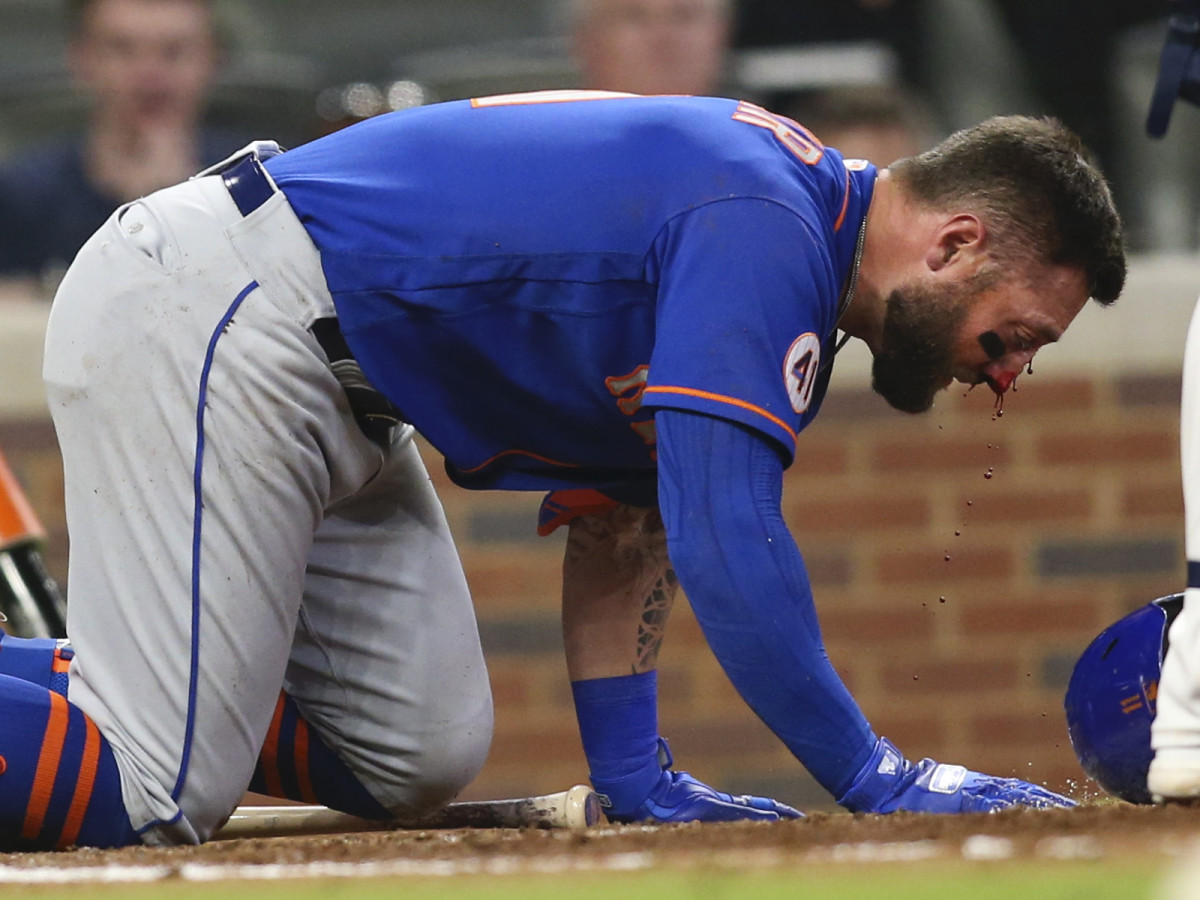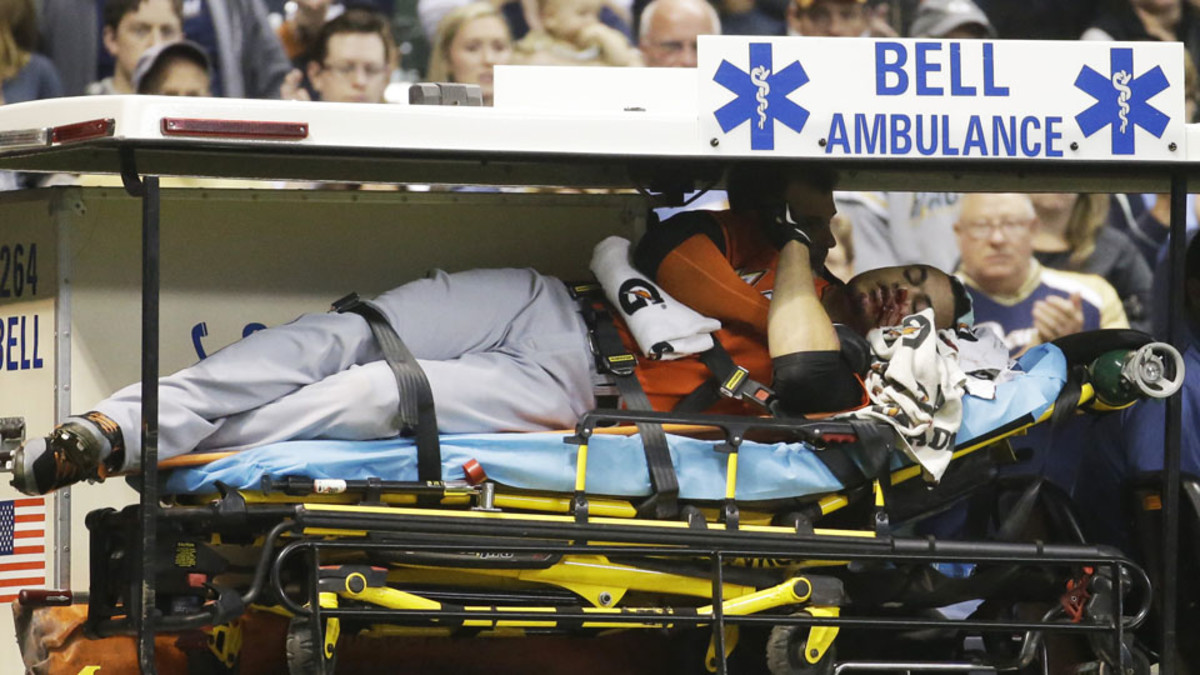MLB Must Act Before Beanballs Hurt Players and the Game
Another extremely ugly hit-by-pitch stole the show on Monday Night Baseball.
With the bases loaded in the seventh inning of a 1–0 game between the Mets and Braves, Kevin Pillar was hit in the face with a 94 mph fastball thrown by Braves reliever Jacob Webb. Blood immediately started gushing from Pillar’s nose as he helplessly crawled around the batter’s box and waited for medical help. The ensuing gore had to be powdered over and mixed into the dirt by the grounds crew before play could resume. The delay also felt necessary from an emotional standpoint. Every player appeared to be shaken up to some degree, and it sucked the life out of the broadcast.

A bloodied Pillar—who underwent a CT scan at a hospital Monday night—was able to walk off the field fairly quickly despite the bleakness of the situation. He also later tweeted an encouraging update, saying he was “doing fine” and proudly noting he was credited with the game-winning RBI in New York’s 3–1 win, strengthening his tough guy credentials. The Mets announced Tuesday that Pillar "suffered multiple nasal fractures. He will be meeting with a facial specialist in Atlanta to determine next steps."
Thanks to everyone that has reached out! Scary moment but I’m doing fine! #RBI #gamewinner 👍🏽👍🏽
— Kevin Pillar (@KPILLAR4) May 18, 2021
Obviously, these things happen in baseball, but players have been getting beaned far too often—at a historic pace, in fact. This season has averaged nearly one hit batsmen per game, according to Sports Illustrated's Tom Verducci, as the four seasons with the most hit-by-pitches since 1901 are this year (0.92 batters per game), last year (0.92), the year before that (0.84) and the year before that (0.80).
This isn’t even the first time Pillar has been struck in the face with a pitch in his career. He was also hit on the chin by San Diego’s Dinelson Lamet in 2019, though he was able to play on because it struck his shoulder first to take the brunt of the force away.
Back then, Pillar said, “For me, the biggest challenge was being able to step back in the box against the same guy. I was able to do that and stay in there and I didn’t feel like it affected me at all. As scary as it is, it’s something that happens very infrequently in the game.”
Late last month, Bryce Harper was drilled in the face with a 96.9 mph sinker thrown by Cardinals reliever Génesis Cabrera. It was scary for all. Cabrera was rattled, and he proceeded to plunk Didi Gregorius with his next pitch. Like Pillar, Harper was fine. The Phillies right fielder did miss time with a wrist injury, which was hit after the pitch ricocheted off his face, but he avoided serious problems.
Giancarlo Stanton, then with the Marlins, missed the final weeks of the 2014 season when he was hit in the face with an 88-mph Mike Fiers fastball in a game against the Brewers in Milwaukee. The grounds crew needed to clear up all the blood in the batter's box after Stanton was placed on a stretcher and taken off the field in an ambulance. Stanton suffered a facial laceration, dental damage and multiple facial fractures, including to his orbital bone. As serious as his injuries were, things could've been a lot worse.
"I was really fortunate," Stanton said a week later. "I could have my mouth wired shut now. I could have a plate in my face. I could have a lot of things. I'll take a few missing teeth over all of that.
"You hear about people losing their eye, or you lose vision," he said. "My jaw can be broken. I can lose as many teeth. As long as I'm able to see, that's the big career thing."

Stanton also wasn't sure how he'd react when he returned after such a traumatic experience. As he recovered that offseason, Stanton used a pitching machine throwing inside fastballs to get comfortable again staying in the box. Since then, he wears a face guard attached to his helmet, and he's said having the extra protection is reassuring.
Hopefully Pillar is again able to overcome the mental obstacles he’ll face to step back into the batter’s box. I was brushed on the back by a couple pitches in elementary school, and it derailed my confidence for almost an entire season. Obviously, I’m no major-league player, and that was many degrees away from what Pillar and others have had to endure. But it can be scary to step back into the path of heaters that have the potential to knock you out. Heck, it made Cam Newton quit baseball in middle school.
And while hit-by-pitches may happen somewhat infrequently in the grand scheme of the game, they’ve increased to unprecedented levels, and pitchers are throwing harder than ever. Superstars such as Harper, Mike Trout, Corey Seager, Ronald Acuña Jr., Mookie Betts and Shohei Ohtani have already been forced to miss time this season after getting plunked. This is becoming a player safety issue that could decrease the value of MLB’s product. The NFL has tried to discourage hits to the head, and MLB commissioner Rob Manfred should do the same.
ESPN’s announcers said Pillar’s absence cast a pall over the ballpark Monday, even though the Mets were playing on the road in Atlanta. Does MLB, which is already grappling to adapt baseball to a modern audience, want to see this trend continue and allow more agony to seep into the sport? Will they wait for another player to follow in the footsteps of Ray Chapman, whose 1920 death after being hit in the head prompted a crackdown on doctored balls?
Perhaps the answer is to mandate some sort of extended face mask for hitters, similar to the one Stanton uses. Perhaps it’s moving back the mound a few feet to give players more reaction time (which would also help alleviate the sport's suffocating amount of strikeouts). Whatever it is, it’s time to stop waving this away as part of the game and look for a solution before someone else gets seriously hurt.
More MLB Coverage:
• Verducci: What's Behind Baseball's Hit-By-Pitch Epidemic?
• Martell: MLB Must Amend Three-Batter Rule After Scary Situation
• Laws: Pujols Bests Bumgarner in Ideal Dodgers Debut
• Verducci: Inside the Devastating Gig Economy of Relief Pitching
